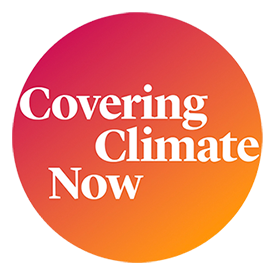 This story is part of Covering Climate Now, a global journalism collaboration strengthening coverage of the climate story.
This story is part of Covering Climate Now, a global journalism collaboration strengthening coverage of the climate story.
It’s long past time for journalism to recognize that the climate emergency is here. To be clear, that is a statement of science, not politics—and the science says the hour is very late.
As a cofounder of Covering Climate Now, a global consortium of hundreds of news outlets reaching roughly 2 billion people, The Nation joins the following CCNow partners in urging colleagues throughout the media to acquaint themselves with the relevant science and cover the climate story accordingly: Columbia Journalism Review (also a CCNow cofounder), The Guardian (CCNow’s lead media partner), Al Jazeera English, The Asahi Shimbun, The Guardian, La Repubblica, Scientific American, and Noticias Telemundo. We are inviting journalists and news outlets everywhere to join us in signing the Climate Emergency Statement that has been posted on Covering Climate Now’s website.
Many of the world’s top scientists now say humanity faces a “climate emergency.” Among them are James Hansen, the former NASA scientist whose 1988 US Senate testimony put the climate problem on the public agenda, and David King and Hans Schellnhuber, former science advisers to the British and German governments, respectively. And some 14,000 scientists have signed the “World Scientists’ Warning of a Climate Emergency.”
Why “climate emergency” rather than “climate problem” or even “climate crisis”? Because words matter.
To preserve a livable planet for today’s young people, science says, humanity must take far-reaching action immediately. Failure to slash the amount of carbon dioxide in the atmosphere will make the extraordinary heat, storms, wildfires, and ice melt of 2020 routine and could “render a significant portion of the Earth uninhabitable,” warned a recent Scientific American article. And because carbon dioxide remains in the atmosphere for many decades after being emitted, the longer we wait to take strong action, the more extreme weather there will be—and the greater the likelihood of crossing points of no return.
As journalists ourselves, we understand why some of our colleagues are cautious about initiatives like this Climate Emergency Statement, but we ask that they hear us out. Journalists rightly treasure our editorial independence, regarding it as essential to our credibility. To some of us, the term “climate emergency” may sound like advocacy or even activism—as if we’re taking sides in a public dispute rather than simply reporting on it.
But the only side we’re taking here is the side of science. As journalists, we must ground our coverage in facts. We must describe reality as accurately as we can, undeterred by how our reporting may appear to partisans of any stripe and unintimidated by efforts to deny science or otherwise spin the facts.
The Covid-19 pandemic has provided a tragic lesson in how important it is for science to guide journalism, and much of the news media has responded admirably. In accordance with the best available evidence, journalists have described the pandemic as a public health emergency. They have chronicled its devastating impacts, called out disinformation, and told audiences how to protect themselves (with masks, for example, and vaccinations).
Now, we need the same commitment on the climate story. Signing the Climate Emergency Statement is a way for journalists and news outlets to alert their audiences that they will do justice to that story. And make no mistake: Polling data indicates that most of the public in the United States and around the world, especially younger people, want more, not less, coverage of climate change, especially on possible solutions.
But whether a given news outlet makes a public declaration by signing the statement is less important than whether the outlet’s coverage treats climate change like the emergency that scientists say it is. The theme for the Covering Climate Now consortium’s April 12 to 22 Earth Day coverage, for example: “Living Through The Climate Emergency,” with stories both on how people are experiencing that emergency and how we all can survive it. As a founding partner of Covering Climate Now, The Nation has been proud to help lead this global effort to increase the quantity and quality of climate coverage throughout the media, working in collaboration with journalists and newsrooms around the world to tell the defining story of our time.
We invite journalists everywhere to join us. The climate emergency demands nothing less.


